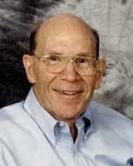Ever since his 1978 best-selling The Pursuit of Holiness in the name Jerry Bridges has been a familiar favorite among a wide spectrum of evangelicals, and in recent years his ministry of writing and speaking in Reformed circles has been received with ever-deepening appreciation. Both his writing and his personal fellowship have been richly appreciated, and the ministry God has given him has been widely and deeply impacting and influential for Christ.
There are some whose names meet with indifference. And there are some when whose name is mentioned you must either duck or pucker. But mention Jerry Bridges, and the responses is always one of grateful appreciation. And so we fully expect that his new autobiography, God Took Me By the Hand: A Story of God’s Unusual Providence, will be his next best-seller. It’s a delightful read, and we recommend it highly. And we’re glad to have Jerry with us today to talk about his life and his newest book.
Books At a Glance (Fred Zaspel):
Tell us something of your early background. What was family life like for you when you were a boy?
Bridges:
I grew up in poverty during the 1930’s depression years. Both my parents dropped out of school after 8th grade to work on their respective family’s cotton farms so I grew up with poor, uneducated parents, although both of them were intelligent. My parents were members of a fundamentalist Baptist church and I grew up in that environment, including the weekly altar call.
Books At a Glance:
How did you come to Christ? And perhaps you can tell us a bit about your early experience with altar calls?
Bridges:
When I was 9 years old I went forward during the altar call. I think our pastor thought that the simple act of going forward was trusting in Christ as savior so no one shared Scripture with me or prayed with me. When I was 11 years old I began to doubt that I was a Christian so I went forward again. Again, at 13, I went forward but sensing that nothing had happened I said to myself, “You are not going forward again.” For five years I struggled with assurance of salvation. Finally, at age 18, I accepted the fact that I was not saved so I prayed this prayer, “God, I don’t know if I have to go forward in church again. I don’t want to but if I have to, I’m willing to. But whatever it takes, I want Christ to be my savior.” Instantly I had assurance of salvation.
 Books At a Glance:
Books At a Glance:
What is Navigators? Most people know them only as a book publisher, but what was their ministry like when you first came in contact with them? And while you’re at it, we’d enjoy hearing just how you first came in contact with them.
Bridges:
The Navigators is an interdenominational Christian organization which has ministries in just over 100 countries around the world. The ministry started in 1933 when a young man, Dawson Trotman, began to disciple a sailor aboard one of the ships stationed at Long Beach. Soon this sailor brought another one to Dawson Trotman and asked him to teach the second man what Dawson had taught him. Dawson said, “You do it.” Against the young man’s protests Dawson said, “If you can’t pass on to him what I taught you then I have failed. You teach him and I will coach you.” This principle of one disciple reaching and teaching another believer is probably the fundamental guiding principle of ministry in The Navigators.
I first came in contact with The Navigators in about December of 1951. I was a young Navy officer and was introduced to The Navigators by another Navy officer whom God providentially put in my path. Having received Christ at age 18, I was a Christian but did not know anything about the practice of personal spiritual disciplines which became so important to me aboard a small ship with no chaplain and on which, I think, I was the only believer. At that time, The Navigators’ ministry was mostly to servicemen but beginning in the 1950’s it began to grow into a ministry to university students and the beginnings of ministry to overseas countries.
Books At a Glance:
How did you later become associated with the Navigators, and in what capacity?
Bridges:
After I got out of the Navy in 1953 I continued my association with The Navigators in San Diego as a volunteer. In 1955, while at The Navigators’ conference center in Colorado Springs, I felt a definite call from God to serve with The Navigators the rest of my life. At that time, all prospective staff came to The Navigators’ training facility in Colorado Springs. Although there for training, we each had a regular job, either in The Navigators’ office or in their conference and training facility. My first job was as supervisor of the correspondence department which handled all mail addressed simply to The Navigators. During the end of my supervisor experience we had 17 people working in that department. Although I had expected to become a Navigator staff member working with military people or perhaps going overseas, The Navigators’ leadership asked me to become part of their career headquarters staff. I ended up spending approximately 40 years in Navigators administration.
 Books At a Glance:
Books At a Glance:
What positions you have held with the Navigators?
Bridges:
In 1956 one of the earliest Navigators from the 1930’s retired from the Navy and came to our conference and training facility as what we would now call the chief operating officer. Because of my experience as a naval officer he asked me to work for him. In actuality, I filled in whatever need The Navigators had. I once asked my boss where I fitted in The Navigators. He responded, “You are like a utility player on baseball team. You fit in wherever you are needed.” Consequently, I was at one time the manager of buildings and grounds at our conference center. After that, a 3 year stint as administrative assistant to our Europe director. I later became the manager of the entire headquarters’ office and from that to the position of secretary treasurer of The Navigators Corporation. In 1954, when I was 34 years old, I was Vice President of Corporate Affairs but I began to transition out of that role to more emphasis on Bible teaching and writing. In 1995, at age 65, I became a full-time writer and Bible teacher. I have served primarily in our collegiate ministry doing staff development and serving as a speaker resource to our collegiate staff.
Books At a Glance:
You mention in your book that although you never attended a seminary, you did consider it for a time and in fact looked into three of them. Which seminaries were they?
Bridges:
In 1955 just before joining the staff as a staff trainee I considered going to seminary. Actually, I was unfamiliar with the wide range of choices. The only ones I was aware of were Fuller Theological Seminary, Wheaton Graduate School and Columbia Bible College Graduate School. I sent to all three schools for catalogues and none of them aroused my interest. That was God’s way of leading me along a different path of self study.
Books At a Glance:
The story of how you came to understand and embrace the doctrine of election is a fascinating one. The important turning point was a booklet given to you in 1960 by an older lady in your church in San Diego. What was that booklet – and do you remember the author? And was that lady aware of the impact this moment had on you?
Bridges: The name of the booklet was The Doctrine of Election. I’m not sure but I think the author was A.W. Pink. My first reaction to the book was that coming from basically an Arminian view of salvation; I was very offended by the message of the book. In fact I thought she’s gotten into heresy. However, the next morning, in my time with God, he opened my eyes of understanding so that I came to embrace the doctrine of election. This was just prior to my departure for my three years in Europe. I wrote to her and told her what had happened. She had a large library of Puritan and Reformed books which she began to send to me. It was through those books that I began to get my theological education.
To Be Continued!
Click here to see part 2 of our interview with Jerry Bridges.

